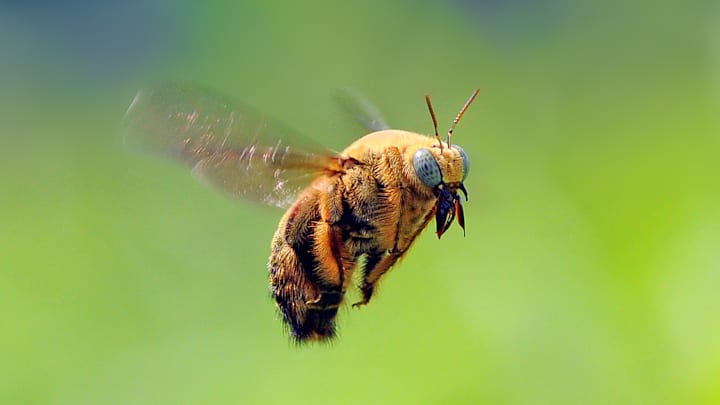“Kevin sure made a beeline for that buffet,” one might say. Or, “Sarah made a beeline for the ER after breaking her tibia.” Every day, millions of people use the idiom make a beeline when describing someone who wants to travel as quickly and as efficiently as possible to their destination. But do bees actually travel in a beeline?
- The Meaning of Make a Beeline
- Do Bees Actually Fly in a Beeline?
- As the Crow Flies vs. Making a Beeline
The Meaning of Make a Beeline
The etymological roots of making a beeline began with beekeepers. According to the Oxford English Dictionary, one of the first printed usages of the phrase appeared in 1828, when the research journal American Quarterly Review used beeline to describe the movement made by bees when beekeepers observed their flight patterns. After being released from captivity, the bees were able to ascertain the location of the hive. Thus, beeline didn’t necessarily refer to the insects’ flight pattern but their ability to zero in on their nest.
“The bee-hunter […] encloses [bees] in a tube, and letting one fly, marks its course, by a pocket compass,” the Review stated. “Departing to some distance, at right angles to the bee-line just ascertained, he liberates another, observes its course, and thus determines the position of the hive, which lies in the angle made by the intersection of the bee-lines.”
Almost immediately, making a beeline was co-opted as an idiom. “I drew a bee line to the next tavern, where […] I had no difficulty in calling for two quarts of oats, some cold victuals, and a glass of whiskey in the old way,” wrote a possibly not-quite sober columnist in the New York Spectator in 1829. Making a beeline essentially meant having the same focus and urgency to arrive at one’s metaphorical beehive as a bee.
Do Bees Actually Fly in a Beeline?
Sometimes beeline is understood to mean bees flying in a straight line, but that’s not necessarily the case. When encountering wind turbulence, for example, bees will fly in a zig-zag pattern. Bees make sharp turns or execute evasive maneuvers to avoid the worst of the resistance. Beeline really refers to their lack of stops or distractions when flying home after collecting nectar or pollen, not that they rigidly fly like an airplane through the air. (They also tend to move in a beeline when traveling from their hive toward pollen.)
As the Crow Flies vs. Making a Beeline
There’s a similar idiom to making a beeline, though it doesn’t seem to be used nearly as often: as the crow flies. When giving directions to a place of business, someone might say, “Go 20 miles east as the crow flies.”
According to the OED, the phrase dates back to 1803 and refers to traveling “in a direct line, without any of the detours caused by following the road.” Crows don’t need to concern themselves with any ground obstacles, so traveling as the crow flies means taking a bird’s-eye view of a route.
So what’s the difference? You can make a beeline for that buffet table even though there might be obstacles (like co-workers or waitstaff) in your way. If you travel as the crow flies, you conceive of your route as if there were no obstacles.
One more bit of bee-related business: While most people are familiar with the phrase busy as a bee, not all bees are workaholics. So-called cuckoo bees are actually somewhat parasitical, glomming off the work (and pollen) of honest bees. Some worker bees tend to the hive but take frequent breaks. So being busy as a bee isn’t necessarily an indicator that you’re all that busy.
Get Answers to More Big Questions:
